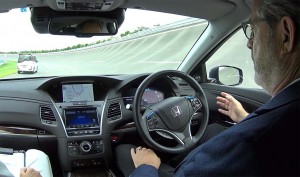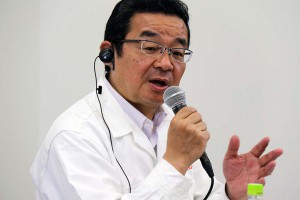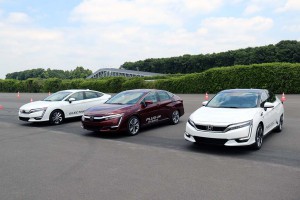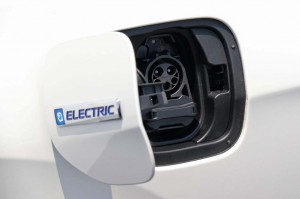Honda has long had a reputation for building solid, reliable and fun-to-drive cars and utility vehicles, but it has been slow off the mark in adapting some of the key, cutting edge technologies that are likely to define the automotive world in the decades to come. But that’s about to change, the second-largest of the Japanese automakers lifting the kimono as part of a media tour of its vehicle proving grounds this week.
Among the key revelations made during an opening session, Honda President and CEO Takahiro Hachigo said the carmaker has put its autonomous driving efforts into high gear in a bid to catch up with traditional rivals like Toyota, General Motors and Volkswagen, as well as new auto brands and tech players, such as Tesla, Waymo and Uber.
Honda will put its first hands-free models into production in 2020, although they will only allow autonomous operation on limited-access highways, with a driver at the ready to take control, if needed. Beyond that, said Hachigo, “We will strive to achieve the technological establishment of Level 4 automated driving for personal car use by around 2025.”
Moving from so-called Level 3 capabilities to Level 4 is a significant step forward. It would allow fully hands-free driving under virtually all circumstances – but for operation in rare situations, including extreme weather and perhaps the sort of traffic conditions one might experience during rush hour in Beijing or Cairo.
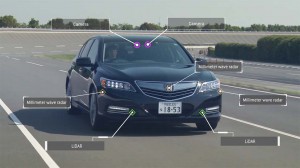
For the moment, Honda's autonomous technology is solely camera-based, but this schematic reveals some of the other sensors it plans to integrate going forward.
(Click Here for a test drive of the new Honda Civic Si.)
Hachigo has been moving fast to upgrade Honda’s focus on technology since being promoted to president in 2015. He has also expanded its green car efforts which, until recently, had largely been focused on conventional hybrids and hydrogen fuel-cell vehicles. The carmaker’s cautiousness was underscored by a Navigant Research study released earlier this year ranking Honda just 15th among 18 companies whose autonomous vehicle programs it studied.
During the media tour, Honda rolled out two self-driving prototypes, demonstrating with one how it hopes its first, Level 3 production model will operate in 2020. On the company’s 2.5-mile oval test track, the car was able to pass a slower-moving vehicle and, further on, go with the flow of a simulated traffic jam. For the Japanese market, the vehicle would allow a motorist to watch videos on its console-mounted navigation screen, or make video calls. A live demonstration was automatically cut off once traffic cleared and the vehicle began to speed up again.
The second autonomous prototype was configured to operate at Level 4, a much more challenging task. That means being able to calculate, just like a human driver, where the lanes are on a poorly marked road, for example, and anticipating what another vehicle might do at a four-way intersection.
Rolling around the proving ground’s more crowded streets, this prototype added advanced AI, or artificial intelligence to its toolkit, making constant calculations based on data gather by three cameras mounted at the top of the windshield.
While the drive proved impressive, it also demonstrated how far Honda has to go to catch up. Unlike the autonomous vehicle prototypes in use by the likes of Ford, GM and Waymo, the Level 4 Honda prototype was notably missing their advanced sensor fusion systems. The maker is just now starting to integrate technologies most experts believe will be key to higher levels of autonomy, notably including radar and a high-definition 3D version of laser, called LIDAR. Those capabilities are set to be integrated into the Honda program in the coming months.
That said, Honda’s AI technology, dubbed Deep Learning, could help it close the gap to competitors, said autonomous program manager Yoichi Sugimoto, who told TheDetroitBureau.com, “Our AI is remarkably improving the vehicle’s performance.”
(Honda fires up its Silicon Valley research arm in search of innovation. Click Here for the story.)
For his part, CEO Hachigo became clearly touchy when a reporter suggested Honda was lagging behind key competitors. “We are not trying to catch up with others but we are trying to achieve something unique to us,” Hachigo told reporters.
It certainly could help that Honda will now also get some outside help from a company widely considered one of the leaders in autonomous vehicle technology. In December, the carmaker announced it was setting up a joint venture with the Google self-driving spin-off Waymo.
What they have in mind remains a mystery, however, neither Sugimoto, CEO Hachigo or anyone else at Honda ready to disclose what Waymo will bring to the table. Speculation has centered around the possibility of a project similar to a separate joint venture between Waymo and Fiat Chrysler Automobiles. FCA is providing about 200 of its Chrysler Pacifica Hybrid minivans to the autonomous vehicle company. They are being outfitted with Waymo technology for field tests, including a pilot ride-sharing project that was launched in the Phoenix area in April.
(For more on Waymo’s autonomous ride-sharing program, Click Here.)
Hachigo was candid about the challenges Honda faces trying to keep up with all the new technologies expected to be integrated into the automobile in the decades ahead. “We cannot do everything by ourselves,” he stressed during a closing Q&A session with reporters.
Another area it is looking for partners is in its green car program. Honda launched its first hybrid-electric vehicle at roughly the same time as Toyota. Their approach to zero-emissions technology has been surprisingly similar ever since. Both companies have remained focus on conventional hybrids – though with its Prius model, Toyota has been far more successful in penetrating the mainstream, high-volume market. Both automakers have also made hefty commitments to hydrogen fuel-cell vehicles while hesitating to push into plug-based alternatives.
In January, Honda took a big step forward, entering a joint venture with General Motors to set up a U.S. manufacturing plant for hydrogen fuel-cells, technology that could be used in both vehicles like the Honda Clarity FCV, as well as in stationary power applications. The venture is expected to help slash the currently exorbitant cost of assembling fuel cells, largely by hand.
But Honda is also broadening its zero-emissions efforts, and will be bringing both plug-in hybrid and pure battery-electric models to market. The first major application will come during the 2018 model-year, with two additional versions of the Clarity, one a PHEV, the other a BEV.
(Now there are three. Click Here for more on all three Honda Clarity models.)
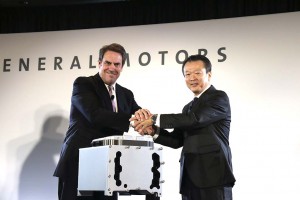
GM Global Product Development Director Mark Reuss and Honda North America CEO Toshiaki Nikishiba celebrate their new joint venture alongside the fuel-cell stack they plan to build.
There are numerous skeptics about this approach, particularly the pure battery version of the Clarity. With only 100 miles of range per charge, it is coming to market just as other makers are rolling out mainstream-priced models with two to three times that range. These include the Chevrolet Bolt EV, the upcoming Tesla Model 3, and the redesigned Nissan Leaf.
Honda officials insisted the shorter-range Clarity EV will be “good enough” for those who want a green machine for basic daily driving, but there’s growing industry consensus that a minimum 200 miles range will be needed to crack mainstream demand.
During the two-day program at the Honda proving grounds, company officials said they have other models in the works. While specifics were in short order, a senior official in the new battery-electric division, Minami Katsuya, told TheDetroitBureau.com we will likely get a first look at a 200-mile Honda EV late in 2018.
“That will increase its potential,” Hachigo acknowledged, when asked about the vehicle quietly under development.
That would certainly seem critical to the CEO’s most cherished transformation target. His goal, he emphasized during both the opening and closing sessions, is to have “electrified vehicles account for two-thirds of Honda’s sales by 2030.” And many of them, it now appears, will offer some level of autonomous capabilities, as well.
The two-day session at the Honda technical center, an hour’s bullet train ride outside Tokyo, offered a candid look at a company in transition. In some key areas, it revealed that the automaker has to redouble its efforts to catch up with industry leaders. But it also left little doubt that Hachigo is giving his research and product development teams the tools they are going to need to keep pace.
(Click Here for a review of the brand-new Honda Odyssey. Can it make minivans sexy again?)

